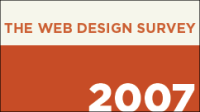It is common knowledge that some HTML elements display differently across browsers, even when no extra styling is applied to them. Thus, sometimes it is justified to start designing on a level playing field by resetting margins, padding, heading sizes, etc. to some kind of default values. How would you go about that task?
Happy birthday, HTML WYSIWYG editors! On February 26th, 1991, Tim Berners-Lee presented to the world Nexus, the very first browser and WYSIWYG editor.
The great webzine Smashing Magazine has a record of publishing exquisite articles on web related matters. Their latest piece, 10 Principles Of Effective Web Design, is an inspirational must-read for everyone who makes websites.
 Among justsayhi.com's collection of funny widgets, right next to the "Can you survive a zombie apocalypse" quiz, there are two quizzes for web designers. They are called "How many HTML elements can you name in 5 minutes" and "Home many CSS properties can you name in 7 minutes." The premise is simple: once you open the page the clock starts ticking and you need to write HTML tags or CSS properties in a text box. After the time is up, you get a summary of what you got right and what you missed.
Among justsayhi.com's collection of funny widgets, right next to the "Can you survive a zombie apocalypse" quiz, there are two quizzes for web designers. They are called "How many HTML elements can you name in 5 minutes" and "Home many CSS properties can you name in 7 minutes." The premise is simple: once you open the page the clock starts ticking and you need to write HTML tags or CSS properties in a text box. After the time is up, you get a summary of what you got right and what you missed.
 If, for whatever reason, you wish to wrap text in a novelty way, the CSS Text Wrapper is just the free online tool for you. It allows you to wrap text in a form that you can draw, on the web site, with a simple control point system. The application even has the option automatically to trace an uploaded image and then place the text in the resulting form.
If, for whatever reason, you wish to wrap text in a novelty way, the CSS Text Wrapper is just the free online tool for you. It allows you to wrap text in a form that you can draw, on the web site, with a simple control point system. The application even has the option automatically to trace an uploaded image and then place the text in the resulting form.
Good news everyone! Microsoft has decided to make upgrading to Internet Explorer 7 mandatory by bundling the newer browser into a mid-February autoupdate. Now, you may say this is not "mandatory" in the true sense of the word, and you may be right, but this step on behalf of everyone's favorite megacompany is sure to bring IE6 closer to a single-digit market share percentage. Who knows, maybe one day soon you won't be required to test your HTML and CSS code against IE6?
 The first beta version of the second most popular browser's third iteration is freely available for download from Mozilla. While this is not a nightly build, the software is not recommended for casual users until a more mature version is available. Which is to say that the only reason for you to want to take Firefox 3 for a test drive is pure curiosity.
The first beta version of the second most popular browser's third iteration is freely available for download from Mozilla. While this is not a nightly build, the software is not recommended for casual users until a more mature version is available. Which is to say that the only reason for you to want to take Firefox 3 for a test drive is pure curiosity.
According to this schematic, beautiful HTML is well ordered, with properly declared doctype, using semantically clean menus, etc. The image explains how you would go about creating a structured, validating HTML code.
 The Aptana project started in 2005 with the purpose of creating a complete toolkit for web developers and designers. After a number of beta and milestone releases, this week the developers finally announced the finished product and branched the application into a free community edition and a paid professional one. Does Aptana Studio, an Ajax-oriented "Web IDE," really provide a new breed of a product, serving the needs of developers and designers? And if it does, is it suitable for that category of casual internet users who only support a personal site and a blog or two?
The Aptana project started in 2005 with the purpose of creating a complete toolkit for web developers and designers. After a number of beta and milestone releases, this week the developers finally announced the finished product and branched the application into a free community edition and a paid professional one. Does Aptana Studio, an Ajax-oriented "Web IDE," really provide a new breed of a product, serving the needs of developers and designers? And if it does, is it suitable for that category of casual internet users who only support a personal site and a blog or two?
 Back in April, the prominent ezine A List Apart started a survey of "people who make websites." The findings of their Web Design Survey have been announced earlier this month and are available for free download as a 1.6 MB, 82 page PDF document.
Back in April, the prominent ezine A List Apart started a survey of "people who make websites." The findings of their Web Design Survey have been announced earlier this month and are available for free download as a 1.6 MB, 82 page PDF document.
